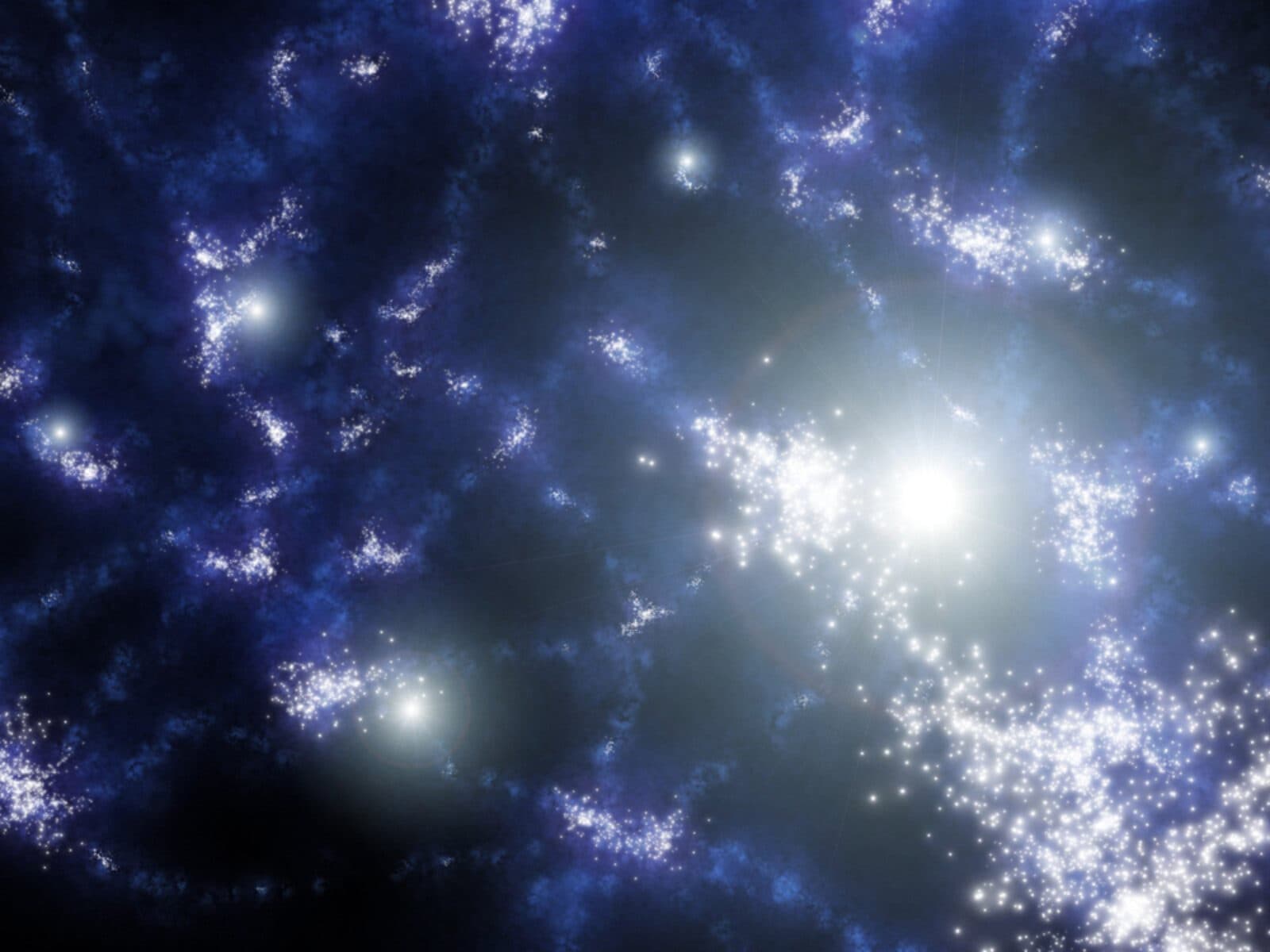Now, Brought to the Big Screen by Astrophysicists at KIPAC: the Universe
New animations from KIPAC bring the cosmos to vivid life

The Researchers
(Originally published by Stanford University News)
The mysteries of the universe – from the first stars and supernovas to galaxy clusters and dark matter - are being revealed in stunningly beautiful full-color, high-definition 3-D videos played on a huge screen in an intimate theater on the SLAC National Accelerator Laboratory campus.
Diaphanous veils of semi-transparent fluorescing gas and dust swirl hypnotically among exploding stars; colliding galaxies dance a cosmic do-si-do before they coalesce. These are some of the compelling scenes shown in the second-floor Visualization Lab of the Kavli Institute for Particle Astrophysics and Cosmology (KIPAC).
In addition, KIPAC's newly redesigned website features an elegant gallery for the movies and images.
Each animation lasts just a minute or three. But whether it depicts only the few milliseconds of a supernova explosion or nearly 14 billion years of cosmic evolution, each KIPAC video shows the results of calculations involving trillions of bytes of data, and marries the latest physics theories with groundbreaking visualization techniques. The videos give scientists insights into their research that cannot be gleaned from old-school data-dump printouts. And they're as entertaining as they are educational: the videos are featured in planetarium shows now playing to the general public in New York City and San Francisco.
As beautiful as the 3-D videos are, though, they are first and foremost scientific tools.
"I'm trying to predict the past – how the universe came to be the way that it is today," said Tom Abel, an associate professor of physics at Stanford University and head of KIPAC's computational physics department, who specializes in using computer calculations and visualizations to understand how the universe may have evolved after the Big Bang.
The visualization lab is part of a KIPAC computing and information center created with a $1 million donation from software entrepreneur Pierre Schwob.
The first step in making a KIPAC visualization is a numerical simulation, an iterative series of physics calculations often performed on a supercomputer, that determines the composition, distribution, temperature and other properties of matter on a cosmic scale. Visualization Lab Manager Ralf Kaehler then uses rendering techniques, many of which he developed himself, to convert the simulation results into the series of images that becomes the video.
Varying the audience's viewpoint by zooming in or out, panning across the scene or even flying through it can enhance a sequence's scientific and artistic appeal. Kaehler uses the latest graphics cards, each of which is as capable as an entire supercomputer was just 10-20 years ago.
"Creating these animations is a real joy these days because computers and software are so much more powerful today," Abel said. "Not long ago it took us weeks to produce a single animation. Now we can do one in an afternoon."
"It's an immersive environment," Abel said. "You can explore three-dimensional data, 'Avatar'-style. It's wonderful to have the sensation of being inside the cosmological data."
Comparing the visualizations with actual observations helps the scientists improve the accuracy of their theories.
Kaehler's videos, for example, have helped Stanford and SLAC Professor Risa Wechsler, KIPAC post-doctoral researcher Oliver Hahn and colleagues understand the formation and structure of galaxy clusters, which are the largest structures in the universe. Each galaxy cluster comprises thousands of galaxies spread over a distance of 13 million light-years orbiting a common center. Wechsler and Hahn's simulations are truly cosmic in scale: they predict the evolution of more than 100 galaxy clusters within a cube 4.5 billion light years on a side.
The calculations take into account the countervailing forces of gravity, which attracts the galaxies toward each other, and the accelerating expansion of the universe, which pushes them apart. Each of the 100 million particles in their video represents about 100 million solar masses.
Other KIPAC videos showed how the universe's first stars formed from minor, post-Big Bang irregularities in the distribution of mass seen in the cosmic microwave background. Those first luminous objects in the universe shone a million times more brightly than our sun, Abel said.
"They died quickly and seeded the cosmos with the chemical elements necessary for life," he said. "Just 100 million years after the Big Bang, galaxies started to assemble, one star at a time, and they are still growing today."
Changing various parameters of a simulation enables researchers to see how theoretical details, such as specific properties of dark matter and dark energy, may affect the universe's appearance today.
As Hahn put it, "These videos aren't just screensavers. They show us how the universe really works."